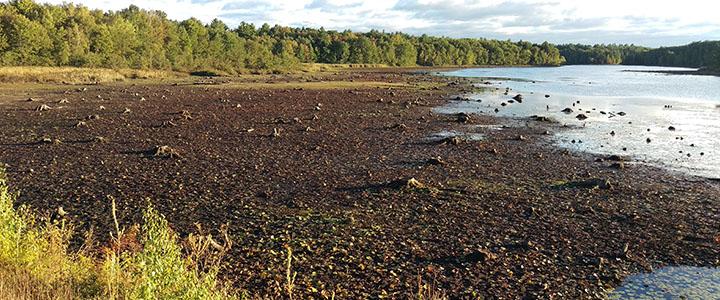
Drought: Water Restrictions and Cutting Out Water Waste
Unlike other natural disasters, a drought is slow moving. Its emergence and impacts are often not observed by the general public until the drought has developed in intensity. Unfortunately, at that point, drought impacts are often more difficult to manage. That’s why NHDES, as the lead agency of the state’s Drought Management Team (DMT), continually tracks drought conditions and impacts in New Hampshire, as well as provides timely drought guidance. Long before a drought emerges, NHDES is tracking drought development and preparing for a drought response. For example, while parts of the state were not designated as experiencing drought until the end of this past June, NHDES began carefully tracking conditions in early spring.
A lighter than normal snowpack and below normal precipitation in the spring, when the groundwater recharge is usually at its peak, signaled caution ahead. As the precipitation deficit continued and dry conditions took hold in mid-June, NHDES began a variety of efforts including keeping hundreds of drinking water systems, municipalities, and the public informed of drought development and conservation measures that should be taken. As the drought developed in intensity, NHDES’ recommendations for conservation followed suit. By the end of the summer, 165 community water systems and 7 municipalities had imposed outdoor water use restrictions.
During this past summer, NHDES received many inquiries about outdoor water use including requests for guidance from municipalities and drinking water systems, citizens concerned about impacts to their well as a result of a neighbor’s excessive outdoor use, and individuals who believed restrictions were unfair. To some it comes as a surprise that NHDES does not have the authority to implement restrictions of its own. Although, as the lead of the DMT and the agency responsible for managing the surface water and groundwater of the state, NHDES does have a responsibility to make recommendations for restrictions and conservation actions to take during a drought to help ensure supplies continue to meet the essential needs of the public. The entities that have authority to restrict water use are drinking water systems, which can impose a variety of outdoor water use restrictions on customers when there is threat to supplies, and municipalities, which have the authority to restrict lawn watering during a drought on private well owners and drinking water systems within its municipal borders.
The types of restrictions imposed and whether the restrictions are voluntary or mandatory can vary for many reasons, such as the supply capacity of a water system or the intensity of the drought. For example, a large drinking water system that can track availability of its water supplies and has multiple back-up water sources may be less threatened during the earlier months of drought than a smaller system or private well owner. Such a system may choose to impose voluntary restrictions until the risk of supply not meeting demand increases. Despite whether a restriction has been imposed or not, it is the responsibility of every water user to use water responsibly during a drought. Water is a finite resource, water supplies are interconnected, and the sustainability of supplies is uncertain, especially as a changing climate alters what we’ve historically considered normal conditions.
Because residential water use is the second largest type of use in the state behind energy production, and residential use increases by an average of 50% in the warmer months due to an increase in outdoor use, cutting back on outdoor use saves a significant amount of water. As the seasons change and the drought persists, the question of what else can be done to conserve during the winter months arises. Three effective ways to eliminate water waste all year long include using water wisely, fixing leaks, and installing higher performing water use fixtures. Basic actions that all members of a household can practice are turning off the faucet while brushing teeth, doing full loads of laundry, and taking shorter showers. For those on private wells, it is also recommended that water use is spaced out to allow for the well to recharge between uses. Another opportunity for saving water that often is overlooked is checking for leaks. Dripping faucets and showerheads can often be remedied by replacing cracked gaskets and adding some plumbers tape to the thread of the fixture. Also, fixing running toilets can save hundreds of gallons a day. If a toilet is running, an adjustment to the flush chain or replacement of the toilet flapper will most likely solve the problem. While an investment, it is often worth replacing old, water-wasting fixtures with new, high-performing fixtures. The savings can include thousands of gallons a year and can shave an average of 10% off utility bills.
Two of the largest water wasters in the home are toilets manufactured before 1994, which can use 5 gallons per flush or more, and washing machines manufactured before 2003, which may use 20 to 30 gallons of water per load. For guidance on selecting a new toilet, look for the EPA WaterSense certification on the product label or display. WaterSense certifies water-using products that use 20% less water than plumbing standards and that are able to pass strict performance standard testing by a third party. Also, Energy Star certified washing machines only use 6 to 12 gallons per load. As less water is heated, less energy is consumed.




